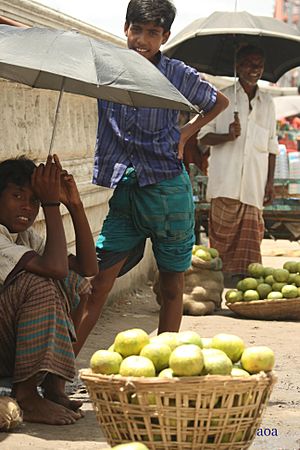Hatkhora facts for kids
Quick facts for kids Hatkhora |
|
|---|---|
 |
|
| Hatxora sellers in Sylhet, Bangladesh | |
| Scientific classification | |
| Synonyms | |
|
The Citrus macroptera is a type of citrus fruit. It's also known by names like Shatkora, hatkhora, cabuyao, Melanesian papeda, or wild orange. This fruit grows semi-wild, meaning it's not fully cultivated by humans. You can find it naturally in the Sylhet region of South Asia, and also in places like Malesia and Melanesia.
Some scientists think C. macroptera is very similar to another citrus fruit called C. hystrix (kaffir lime). They might even consider them the same species.
Contents
What is Citrus Macroptera?
Citrus macroptera gets its name from its leaves. The word "macroptera" means "large wings." This is because the stem part of the leaf, called the petiole, has big, wing-like parts. These "wings" are often as large as the main part of the leaf itself!
The tree can grow up to 5 meters (about 16 feet) tall. It also has thorns on its branches. The fruit itself is usually about 6 to 7 centimeters (2.5 to 2.7 inches) wide. When it's ripe, it turns yellow and has a fairly smooth, thick skin.
Inside, the fruit's pulp is greenish-yellow and doesn't have much juice. The juice it does have is very bitter and a bit sour.
Different Types
Scientists sometimes divide Citrus macroptera into different types, or "varieties." These varieties can sometimes even be seen as separate species. Here are some of them:
- C. macroptera var. macroptera
- C. macroptera var. annamensis
- C. macroptera var. combara
- C. macroptera var. kerrii
Where it is Grown
A special type of C. macroptera var. annamensis is grown in the Sylhet Division of northeastern Bangladesh. This type is called 'Sat Kara' or "hatkhora" by the local people. It's an important crop in that area.
How People Use It
Cooking with Shatkora
In Bangladesh, people mostly use the thick, fleshy skin (rind) of the Citrus macroptera fruit. They eat it like a vegetable! The inside pulp is usually thrown away because it tastes so bitter and sour.
The thick rind is cut into small pieces. It can be cooked when it's green or when it's ripe. People often add it to curries with beef, mutton, or fish. Sometimes, the rind is dried in the sun. This allows people to store it and cook with it later.
The fruit is also a main ingredient in special pickles called satkora or shatkora pickles. You might even find it used in doner kebabs at some fast-food restaurants run by British Bangladeshis.
Using it for Perfume
Many C. macroptera var. annamensis fruits are sent from Bangladesh to other countries. These fruits are quite valuable because their oil is used to make perfume. The oil gives perfumes a unique scent.

